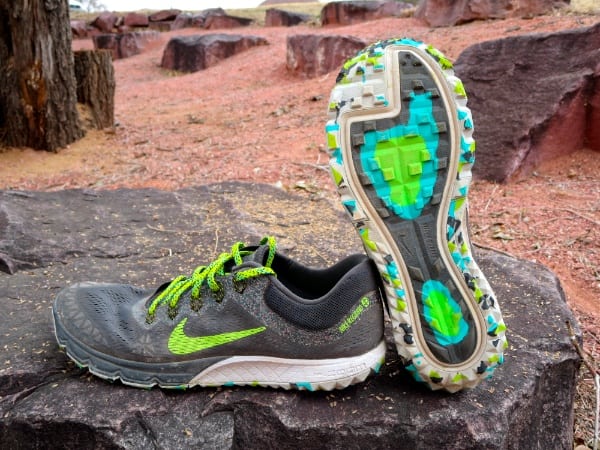For the latest on the Nike Kiger, you can read our Nike Kiger 10 review.
Our Favorite Trail Running Shoes
Check out our Best Trail Running Shoes article to learn about our current favorite trail running shoes!
Nike Terra Kiger 2 Review
Without a doubt, the Nike Terra Kiger 2 ($125) is a lightweight (8.5 ounces), amazingly well cushioned, and minimal-feeling trail running shoe that will appeal to a lot of runners looking for both a race-day shoe and a daily trainer.
While the number of offerings in Nike’s trail-shoe lineup remain small, the impact of these shoes on the trail running market has been anything but subtle. Rather than releasing a torrent of new trail running shoes (as I expected they would), Nike chose to tweak its current platform which supports both the Terra Kiger and Wildhorse. While I would love to provide a sweeping overview of the changes to both shoes, Robbie Lawless already beat me to the punch with a great interview with the design team at Nike. I reviewed the original Terra Kiger back in May after putting some significant miles on them. My goal with the Kiger 2 was to do the same, and throughout the summer and fall this shoe became my go to for basically any type of trail running, from crushed gravel to technical 10ks where footing and traction are a high priority.
What follows is a personal critique of why this particular Kiger didn’t work too well for my foot, and suggestions for further improvements to an already classic trail shoe.

The Nike Terra Kiger 2.
Upper
Nike made some great tweaks with the Kiger 2 upper which makes it a more-stable performer on technical trails and provides a little more durability. Welded overlays cover a larger portion of the toe box in high-wear areas and a minimal layer of rubberized material (possibly Nike Regrind?) reinforces the lacing structure and the heel of the shoe. Great changes were made in the heel-cup area to reinforce the somewhat sloppy, Nike Free 3.0-like, feel of the original Kiger’s heel. The overall fit remains mostly the same (size up 1/2 size!), but this Kiger has a more locked-in feel that inspired confidence on downhills and loose terrain. The lacing system remains the same, with Dynamic Flywire and a sock liner thrown in to reinforce a glove-like fit.
One area that changed significantly is the amount of material in the toe box. Luckily, the toe box remains wide with a more natural last, but the toe box on the Kiger 2 is shallow. This caused me somewhat of a claustrophobic feeling on my first few runs and prohibited me from wearing anything but my thinnest running socks. While the toe-box material does stretch and give a bit with additional miles, this toe box provided some problems for me which didn’t start to surface until almost 200 miles in the shoe. More to come on that…

The Nike Terra Kiger 2’s lateral upper.
Midsole
While I initially scoffed at the lack of rock plate in the original Kiger, this second version doesn’t need one. Why? Nike increased the firmness (durometer) of the forefoot cushioning ever so slightly so that it provides more protection from rocks, but it also provides more responsiveness. Nike’s Phylon midsole material, coupled with Zoom Air units in the forefoot and heel, provide one of the best rides on the market. The lack of a rock plate also helps keep the Kiger 2 flexible, but not to a ridiculous degree. As a mild, late-stage overpronator, the Kiger 2 provided just enough stability due to the higher-durometer midsole that I had no issues wearing this shoe over ultra distances.

The Nike Terra Kiger 2’s medial upper.
Outsole
Nike uses its Regrind material in the outsole which is recycled scraps from making other shoes. The result, which I will affectionately refer to as clown puke, provides a colorful, cool looking, and environmentally friendly take on outsole material. This minimally lugged outsole runs great on the roads as well as trails and is surprisingly sticky. The trade off is that this sticky outsole rubber does wear down somewhat faster than something like a Vibram carbon rubber; however, I will always choose a responsive outsole that wears quickly over hard, intrusive lugs. The smaller lugs on the Kiger 2 help shed mud and clay, but this minimal shoe shines in dry conditions. Nike continues to employ a beveled heel, just as in the first version, which encourages midfoot running and helps with cambered trails.

The Nike Terra Kiger 2’s outsole.

An alternate view of the Nike Terra Kiger 2’s outsole.
Overall Impressions
After the folks at Nike provided me with my sized-up Terra Kiger 2, I was initially skeptical about the shallow toe box. This fear waned after about 10 runs in the shoe, when I’d grown used to them and the upper material stretched out a bit. After a few weeks I’d return from trail runs thinking, This may be the best trail shoe I’ve ever worn! The combination of lightweight flexibility and more-than-enough protective cushioning for the ultra distances kept me wearing them daily.
In fact, I will go so far as to say that everything about this shoe is absolutely dialed in, except for two spots:
- Shallow toe box – I’ve deliberately ignored reading other reviews, buyer’s reviews, or talking to other runners about this. In the words of Bryon Powell, “Who likes a shallow toe box?” I haven’t found them yet. Please come forward, you thin-toed gazelles.
- Flywire material over the metatarsal of my big toe – Over time, this area started to get increasingly irritated, and in combination with the shallow toe box, I started to have bunion/metatarsal irritation for the first time in my life.
Now, I will admit that I have ferociously ugly feet, and luckily I was able to compare photos of my feet from college (15 years ago), two years ago, and after wearing the Kiger 2 exclusively for about two months. The swelling had increased, and I was having some pain in my metatarsal after my runs. Please don’t ask me why I have photos of my feet, but I’m curious if other runners have experienced this phenomenon. Since switching to other trail shoes, the swelling and pain have been non-existent.
I’m sure that the Kiger 2 is a shoe that will work brilliantly for a lot of runners. My hope is that this next version will have the aforementioned changes so that I can continue to enjoy them. As always, give me your own reviews, thoughts, and critiques in the comments section below.
Call for Comments (from Meghan)
- Are you running in the Nike Terra Kiger 2? If so, what are the main features of the shoe, both positive and negative, that have drawn your attention?
- For those of you who wore the original Terra Kiger and now this second model, what similarities and differences have you noticed between the models?
- Have you had either of the issues Tom has had with a shallow toe box or big-toe metatarsal problems?
